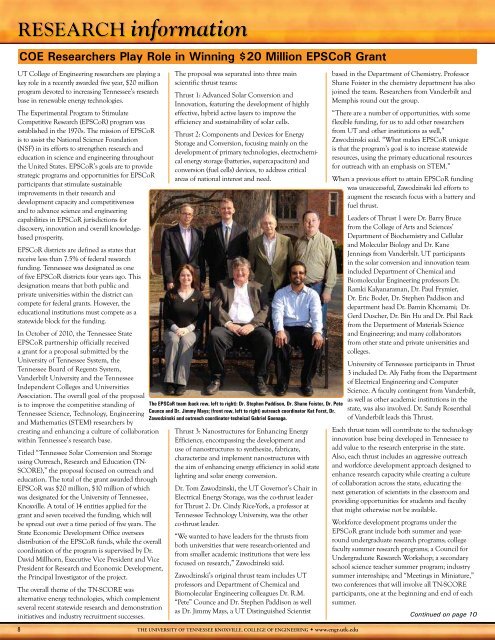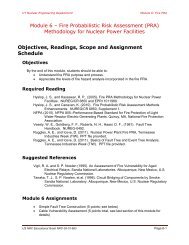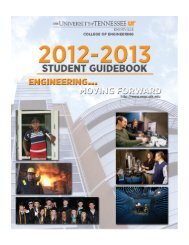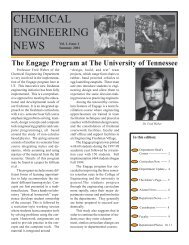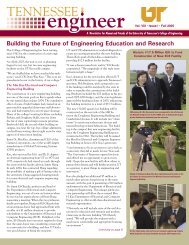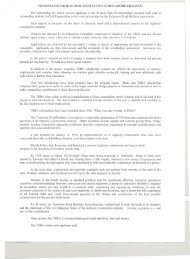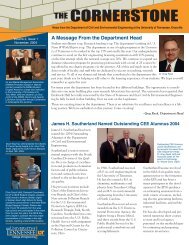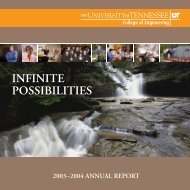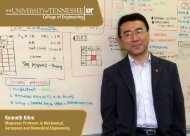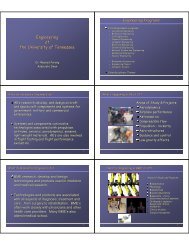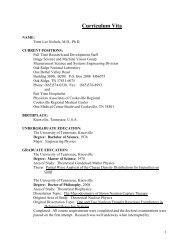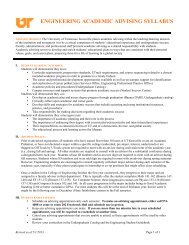Spring 2011 - College of Engineering - The University of Tennessee ...
Spring 2011 - College of Engineering - The University of Tennessee ...
Spring 2011 - College of Engineering - The University of Tennessee ...
- No tags were found...
You also want an ePaper? Increase the reach of your titles
YUMPU automatically turns print PDFs into web optimized ePapers that Google loves.
COE Researchers Play Role in Winning $20 Million EPSCoR GrantUT <strong>College</strong> <strong>of</strong> <strong>Engineering</strong> researchers are playing akey role in a recently awarded five year, $20 millionprogram devoted to increasing <strong>Tennessee</strong>’s researchbase in renewable energy technologies.<strong>The</strong> Experimental Program to StimulateCompetitive Research (EPSCoR) program wasestablished in the 1970s. <strong>The</strong> mission <strong>of</strong> EPSCoRis to assist the National Science Foundation(NSF) in its efforts to strengthen research andeducation in science and engineering throughoutthe United States. EPSCoR’s goals are to providestrategic programs and opportunities for EPSCoRparticipants that stimulate sustainableimprovements in their research anddevelopment capacity and competitivenessand to advance science and engineeringcapabilities in EPSCoR jurisdictions fordiscovery, innovation and overall knowledgebasedprosperity.EPSCoR districts are defined as states thatreceive less than 7.5% <strong>of</strong> federal researchfunding. <strong>Tennessee</strong> was designated as one<strong>of</strong> five EPSCoR districts four years ago. Thisdesignation means that both public andprivate universities within the district cancompete for federal grants. However, theeducational institutions must compete as astatewide block for the funding.In October <strong>of</strong> 2010, the <strong>Tennessee</strong> StateEPSCoR partnership <strong>of</strong>ficially receiveda grant for a proposal submitted by the<strong>University</strong> <strong>of</strong> <strong>Tennessee</strong> System, the<strong>Tennessee</strong> Board <strong>of</strong> Regents System,Vanderbilt <strong>University</strong> and the <strong>Tennessee</strong>Independent <strong>College</strong>s and UniversitiesAssociation. <strong>The</strong> overall goal <strong>of</strong> the proposalis to improve the competitive standing <strong>of</strong><strong>Tennessee</strong> Science, Technology, <strong>Engineering</strong>and Mathematics (STEM) researchers bycreating and enhancing a culture <strong>of</strong> collaborationwithin <strong>Tennessee</strong>’s research base.Titled “<strong>Tennessee</strong> Solar Conversion and Storageusing Outreach, Research and Education (TN-SCORE),” the proposal focused on outreach andeducation. <strong>The</strong> total <strong>of</strong> the grant awarded throughEPSCoR was $20 million, $10 million <strong>of</strong> whichwas designated for the <strong>University</strong> <strong>of</strong> <strong>Tennessee</strong>,Knoxville. A total <strong>of</strong> 14 entities applied for thegrant and seven received the funding, which willbe spread out over a time period <strong>of</strong> five years. <strong>The</strong>State Economic Development Office overseesdistribution <strong>of</strong> the EPSCoR funds, while the overallcoordination <strong>of</strong> the program is supervised by Dr.David Millhorn, Executive Vice President and VicePresident for Research and Economic Development,the Principal Investigator <strong>of</strong> the project.<strong>The</strong> overall theme <strong>of</strong> the TN-SCORE wasalternative energy technologies, which complementseveral recent statewide research and demonstrationinitiatives and industry recruitment successes.<strong>The</strong> proposal was separated into three mainscientific thrust teams:Thrust 1: Advanced Solar Conversion andInnovation, featuring the development <strong>of</strong> highlyeffective, hybrid active layers to improve theefficiency and sustainability <strong>of</strong> solar cells.Thrust 2: Components and Devices for EnergyStorage and Conversion, focusing mainly on thedevelopment <strong>of</strong> primary technologies, electrochemicalenergy storage (batteries, supercapacitors) andconversion (fuel cells) devices, to address criticalareas <strong>of</strong> national interest and need.<strong>The</strong> EPSCoR team (back row, left to right): Dr. Stephen Paddison, Dr. Shane Foister, Dr. PeteCounce and Dr. Jimmy Mays; (front row, left to right) outreach coordinator Kat Forst, Dr.Zawodzinski and outreach coordinator-technical Gabriel Goenaga.Thrust 3: Nanostructures for Enhancing EnergyEfficiency, encompassing the development anduse <strong>of</strong> nanostructures to synthesize, fabricate,characterize and implement nanostructures withthe aim <strong>of</strong> enhancing energy efficiency in solid statelighting and solar energy conversion.Dr. Tom Zawodzinski, the UT Governor’s Chair inElectrical Energy Storage, was the co-thrust leaderfor Thrust 2. Dr. Cindy Rice-York, a pr<strong>of</strong>essor at<strong>Tennessee</strong> Technology <strong>University</strong>, was the otherco-thrust leader.“We wanted to have leaders for the thrusts fromboth universities that were research-oriented andfrom smaller academic institutions that were lessfocused on research,” Zawodzinski said.Zawodzinski’s original thrust team includes UTpr<strong>of</strong>essors and Department <strong>of</strong> Chemical andBiomolecular <strong>Engineering</strong> colleagues Dr. R.M.“Pete” Counce and Dr. Stephen Paddison as wellas Dr. Jimmy Mays, a UT Distinguished Scientistbased in the Department <strong>of</strong> Chemistry. Pr<strong>of</strong>essorShane Foister in the chemistry department has alsojoined the team. Researchers from Vanderbilt andMemphis round out the group.“<strong>The</strong>re are a number <strong>of</strong> opportunities, with someflexible funding, for us to add other researchersfrom UT and other institutions as well,”Zawodzinski said. “What makes EPSCoR uniqueis that the program’s goal is to increase statewideresources, using the primary educational resourcesfor outreach with an emphasis on STEM.”When a previous effort to attain EPSCoR fundingwas unsuccessful, Zawodzinski led efforts toaugment the research focus with a battery andfuel thrust.Leaders <strong>of</strong> Thrust 1 were Dr. Barry Brucefrom the <strong>College</strong> <strong>of</strong> Arts and Sciences’Department <strong>of</strong> Biochemistry and Cellularand Molecular Biology and Dr. KaneJennings from Vanderbilt. UT participantsin the solar conversion and innovation teamincluded Department <strong>of</strong> Chemical andBiomolecular <strong>Engineering</strong> pr<strong>of</strong>essors Dr.Ramki Kalyanaraman, Dr. Paul Frymier,Dr. Eric Boder, Dr. Stephen Paddison anddepartment head Dr. Bamin Khomami; Dr.Gerd Duscher, Dr. Bin Hu and Dr. Phil Rackfrom the Department <strong>of</strong> Materials Scienceand <strong>Engineering</strong>; and many collaboratorsfrom other state and private universities andcolleges.<strong>University</strong> <strong>of</strong> <strong>Tennessee</strong> participants in Thrust3 included Dr. Aly Fathy from the Department<strong>of</strong> Electrical <strong>Engineering</strong> and ComputerScience. A faculty contingent from Vanderbilt,as well as other academic institutions in thestate, was also involved. Dr. Sandy Rosenthal<strong>of</strong> Vanderbilt leads this Thrust.Each thrust team will contribute to the technologyinnovation base being developed in <strong>Tennessee</strong> toadd value to the research enterprise in the state.Also, each thrust includes an aggressive outreachand workforce development approach designed toenhance research capacity while creating a culture<strong>of</strong> collaboration across the state, educating thenext generation <strong>of</strong> scientists in the classroom andproviding opportunities for students and facultythat might otherwise not be available.Workforce development programs under theEPSCoR grant include both summer and yearroundundergraduate research programs; collegefaculty summer research programs; a Council forUndergraduate Research Workshop; a secondaryschool science teacher summer program; industrysummer internships; and “Meetings in Miniature,”two conferences that will involve all TN-SCOREparticipants, one at the beginning and end <strong>of</strong> eachsummer.Continued on page 10Real Problems Make for Real LearningBreast cancer, battery design, solar houses, Alzheimer’s disease, mobile food irradiation and bridgeexpansion are just a few examples <strong>of</strong> the COE’s capstone design projects.Capstone design projects are collaborationsbetween the UT <strong>College</strong> <strong>of</strong> <strong>Engineering</strong> andlocal, national and regional businesses andgovernment entities. <strong>The</strong>se projects allow uniqueopportunities for students to be involved inhands-on, complex research under the direction<strong>of</strong> engineering faculty.“<strong>The</strong>oretical problems are essential for learningprinciples,” said Dean Wayne Davis, “However,engineers like to make things and solve realproblems. Capstone projects connected toindustry partners enable our students to delveinto real engineering issues.”<strong>The</strong> Electric Power Research Institute (EPRI)supports several student design projects, includingone in the Department <strong>of</strong> Chemical andBiomolecular <strong>Engineering</strong> (CBE). A joint projectinvolving 10 students, the project was proposedby CBE’s Dr. Pete Counce, Governor’s ChairPr<strong>of</strong>essor Tom Zawodzinski and adjunct facultymember Dr. J.S. Watson. <strong>The</strong> project focuses onvarious aspects for redox flow battery design.Another long-term capstone design project inCBE is the collaboration with Eastman ChemicalCompany, which has been facilitated by Dr.Charlie Moore for more than 20 years. <strong>The</strong>department sends five to 10 senior chemicalengineering students to work on a process controlissue for Eastman in exchange for class credit.Eastman also has coordinated with theDepartment <strong>of</strong> Mechanical, Aerospace andBiomedical <strong>Engineering</strong> (MABE) on severalcapstone projects supervised by MABE pr<strong>of</strong>essorDr. Don Dareing.Dr. John Schwartz and his students in theDepartment <strong>of</strong> Civil and Environmental<strong>Engineering</strong> are currently collaborating on acapstone design with the <strong>Tennessee</strong> Department<strong>of</strong> Transportation (TDOT) on a road realignmentand bridge expansion over Little Turkey Creekat Kingston Pike and Everett Road intersectionin Farragut, Tenn. <strong>The</strong> objective is to develop aset <strong>of</strong> TDOT roadway construction plans thatinclude a five-lane curb and gutter facility andsidewalks. <strong>The</strong> bridge structure will also be widenedto accommodate the additional lane, sidewalks andcurbs.<strong>The</strong> Department <strong>of</strong> Industrial and Information<strong>Engineering</strong> (IIE) has several capstone designprojects in conjunction with area hospitals andhealth care providers including East <strong>Tennessee</strong>Children’s Hospital, Covenant Health and St.Mary’s Medical Center (now Mercy Hospital).Projects include operating room sterile processingreview; a pharmacy chemotherapy investigation; areview and study <strong>of</strong> the efficiency <strong>of</strong> a medicationadministration process; and procedures used forprocessing patients in an emergency room setting.IIE has also coordinated capstone design projectswith EPRI, American Safety Razor and AmericanAccessories International.In the Department <strong>of</strong> Electrical <strong>Engineering</strong>and Computer Science (EECS), several capstoneprojects are in progress. One notable example isthe Solar Decathlon <strong>2011</strong> Competition projectfor the design, construction and testing <strong>of</strong> acomplete solar house for the U.S. Solar DecathlonCompetition that will take place in Washington,D.C. in September. Supervised by EECS pr<strong>of</strong>essorDr. Leon Tolbert, the design includes an optionallyconnected DC power storage system to allow thehouse to be used in a stand-alone configurationwhen disconnected from the grid. EECS pr<strong>of</strong>essorsDr. Paul Crilly, Dr. Michael Berry, Dr. JensGregor, Dr. Kevin Tomsovic, Dr. Fran Li, Dr. GregPeterson, Dr. Mongi Abidi, Dr. Syed Islam, Dr.Seddik Djouadi, Dr. Ben Blalock and Dr. HairongQi are involved in capstone projects ranging fromelectric vehicles to android-based robot control to awireless dog leash.Dr. Carl Lundin supervised several capstone designprojects for students in the Department <strong>of</strong> MaterialsScience and <strong>Engineering</strong> (MSE). Corporatesupporters <strong>of</strong> the projects provided funding and inkindcontributions and included Lear Corporation,Metal-Tech, Homesteader Trailers and John Deere.<strong>The</strong> MSE department collaborated with the MABEdepartment on the Homesteader Trailers project,which involved a study <strong>of</strong> the breakdown designfor a utility trailer.In the MABE department, Dr. MohamedMahfouz and Dr. Bill Hamel collaborated withUT Medical Center on several capstone designprojects, including developing a touch-sensitivebreast phantom for use in the training <strong>of</strong> medicalpr<strong>of</strong>essionals in clinical breast examinationsand designing and improving a laparoscopictiming device in a simulation lab. Mahfouz alsosupervised projects in coordination with OakRidge National Laboratory (ORNL) to createan epilepsy seizure forewarning system and ananalysis method for early detection <strong>of</strong> Alzheimer’sdisease.MABE faculty member Dareing, adjunctpr<strong>of</strong>essor Dr. Steve Foster and Dr. Butch Irickhave worked with Denso Corporation, Accu-Router, Lexmark, Republic Plastics and CarlisleTire on several capstone design projects formechanical engineering.In the Department <strong>of</strong> Nuclear <strong>Engineering</strong>(NE), research pr<strong>of</strong>essor Dr. Martin Grossbeckis heading up several capstone design projects,including a mobile food irradiation facility,a small mobile reactor designed to fit into atruck for rapid assembly in remote areas and aninstrumented dry fuel storage cask.“Companies who sponsor capstone projects areamong our many corporate partners, and we aregrateful for their support,” remarked Davis. “It’sa win-win situation for both the businesses whichget the power <strong>of</strong> our creative student minds andthe students who develop a better understanding<strong>of</strong> corporate challenges.”Companies who want to explore ways topartner with the <strong>College</strong> <strong>of</strong> <strong>Engineering</strong> maycontact Marc Gibson, Director <strong>of</strong> CorporateDevelopment at 865-974-7592/ mgibson4@utk.edu, Dr. Bill Dunne, COE Associate Dean forResearch and Technology, (865) 974-3608/wdunne@utk.edu, or you may visit http://www.engr.utk.edu for individual department contact listings.8 THE UNIVERSITY OF TENNESSEE KNOXVILLE, COLLEGE OF ENGINEERING • www.engr.utk.edu TENNESSEE engineer • <strong>Spring</strong> <strong>2011</strong> • www.engr.utk.edu9


